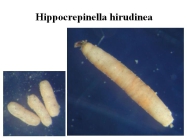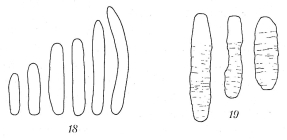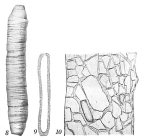WoRMS taxon details
Hippocrepinella Heron-Allen & Earland, 1932
112306 (urn:lsid:marinespecies.org:taxname:112306)
accepted
Genus
Hippocrepinella hirudinea Heron-Allen & Earland, 1932 (type by subsequent designation)
Hirudina Vyalov, 1966 · unaccepted (Opinion of Loeblich & Tappan, 1987)
- Species Hippocrepinella hirudinea Heron-Allen & Earland, 1932
- Species Hippocrepinella remanei Rhumbler, 1935
- Species Hippocrepinella acuta Höglund, 1947 accepted as Bathysiphon acuta (Höglund, 1947) (superseded original combination)
- Species Hippocrepinella alba Heron-Allen & Earland, 1932 accepted as Cribrothalammina alba (Heron-Allen & Earland, 1932) (Type species of Cribrothalammina)
- Species Hippocrepinella ampullacea Rhumbler, 1935 accepted as Bathysiphon alba (Heron-Allen & Earland, 1932) accepted as Cribrothalammina alba (Heron-Allen & Earland, 1932) (Synonym)
- Species Hippocrepinella flexibilis (Wiesner, 1931) accepted as Bathysiphon flexibilis (Wiesner, 1931) (superseded combination)
- Species Hippocrepinella virgulata Rhumbler, 1935 accepted as Bathysiphon virgulata (Rhumbler, 1935) (superseded original combination)
marine, brackish, fresh, terrestrial
recent + fossil
feminine
Heron-allen, E.; Earland, A. (1932). Some new Foraminifera from the South Atlantic. IV. Four new genera from South Georgia. <em>Journal of the Royal Microscopial Society.</em> 52: 253-261., available online at https://doi.org/10.1111/j.1365-2818.1932.tb01872.x
page(s): p. 257 [details] Available for editors [request]
[request]
page(s): p. 257 [details] Available for editors
Hayward, B.W.; Le Coze, F.; Vachard, D.; Gross, O. (2025). World Foraminifera Database. Hippocrepinella Heron-Allen & Earland, 1932. Accessed through: World Register of Marine Species at: https://www.marinespecies.org/aphia.php?p=taxdetails&id=112306 on 2025-05-07
Date
action
by
2006-09-13 06:47:38Z
changed
Martinez, Olga
![]() The webpage text is licensed under a Creative Commons
Attribution 4.0 License
The webpage text is licensed under a Creative Commons
Attribution 4.0 License
Nomenclature
original description
Heron-allen, E.; Earland, A. (1932). Some new Foraminifera from the South Atlantic. IV. Four new genera from South Georgia. <em>Journal of the Royal Microscopial Society.</em> 52: 253-261., available online at https://doi.org/10.1111/j.1365-2818.1932.tb01872.x
page(s): p. 257 [details] Available for editors [request]
[request]
original description (of Hirudina Vyalov, 1966) Vyalov, O. S. (1966), Замечания о фораминиферах с кремневой раковиной - [Remarks on foraminifera with siliceous test], Paleontologicheskiy Sbornik, L'vov 3(1):3-11.
page(s): p. 9 [details]
basis of record Gross, O. (2001). Foraminifera, <B><I>in</I></B>: Costello, M.J. <i>et al.</i> (Ed.) (2001). <i>European register of marine species: a check-list of the marine species in Europe and a bibliography of guides to their identification. Collection Patrimoines Naturels,</i> 50: pp. 60-75 (look up in IMIS) [details]
page(s): p. 257 [details] Available for editors
original description (of Hirudina Vyalov, 1966) Vyalov, O. S. (1966), Замечания о фораминиферах с кремневой раковиной - [Remarks on foraminifera with siliceous test], Paleontologicheskiy Sbornik, L'vov 3(1):3-11.
page(s): p. 9 [details]
basis of record Gross, O. (2001). Foraminifera, <B><I>in</I></B>: Costello, M.J. <i>et al.</i> (Ed.) (2001). <i>European register of marine species: a check-list of the marine species in Europe and a bibliography of guides to their identification. Collection Patrimoines Naturels,</i> 50: pp. 60-75 (look up in IMIS) [details]
Other
additional source
Neave, Sheffield Airey. (1939-1996). Nomenclator Zoologicus vol. 1-10 Online. <em>[Online Nomenclator Zoologicus at Checklistbank. Ubio link has gone].</em> , available online at https://www.checklistbank.org/dataset/126539/about [details]
 Present
Present  Inaccurate
Inaccurate  Introduced: alien
Introduced: alien  Containing type locality
Containing type locality
From editor or global species database
Diagnosis Test free, up to 2 mm in length, irregularly cylindrical, straight to arcuate; wall thin, agglutinated, of very fine sand and mud, poorly cemented and flexible in life, although dried specimens become rigid and fragile, white to dark gray in color, smoothly finished, or may be transversely wrinkled; may have apertures at both ends of the test, one being much smaller than the other, the much constricted openings possibly expand temporarily for the ingestion of food particles but are closed at gametogenesis, and the tiny inequally biflagellate gametes escape from secondarily formed small pores of 15 µm to 20 µm diameter that are scattered over the test surface and then become free swimming. ?L. Pennsylvanian; Permian; Oligocene; Miocene; Holocene, at 100 m to 346 m; S. Atlantic. (Loeblich & Tappan, 1987, Foraminiferal Genera and Their Classification) [details]




